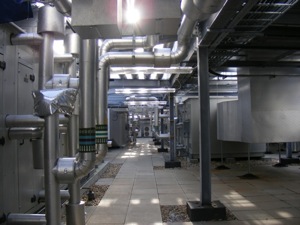This article is more than 1 year old
Inside the Ordnance Survey's new HQ for the digital era
Building designed with servers – and job losses – in mind
But how free is free?
In April this year, as the previous incumbent of Number 10 awaited defeat at the hands of the UK electorate, the Ordnance Survey began releasing to British citizens some of its mapping data for free re-use.
It’s now been six months since the ConDem Coalition was formed, so what does that mean for the OpenOS data project?

“It’s not in flux. The last government had a very clear strategy about making public sector information as freely used as possible,” says the agency’s biz sales and support head John Kimmance.
“[As a trading fund] We have a commercial contract with the government, which means we are paid to release and maintain data into the market and the current government is following the same trajectory as the previous one when it comes to freely used data."
The biz sales head adds: “By free, it depends on how much the cost of data will impact on the government to offer that. And that’s essentially what they [the Coalition] are looking at. So it may well be that more OS data will become free to use down the line, but that’s still to be looked at.”
Given the financial burden involved with essentially footing some of the bill for the Ordnance Survey, is it likely that the org will eventually be sold off as a private business?
“I’m not sure, but it doesn’t make a difference one way or the other. You’ve got an engine room creating a load of data with a whole bunch of surveyors capturing it. That’s delivering a service that the public sector, in particular, is benefiting from and we get commercial revenues from it, too. If the government gave it all away for free, you still need the infrastructure in place to pay for that,” explains Kimmance.
“It doesn’t change the operational side of things, but it might change the business.”

Dr Who-like ground source heat pump system heats, cools building
Meanwhile, the Ordnance Survey, which pulled in sales of £114.3m in 2009/10, is expecting to see revenue growth, despite freeing up some of its data and the fact that the current economic climate is frosty.
Concerns around the free-at-the-point-of-use data so far released have focused mainly on the contentious issue of derived data. However, in October this year, the Ordnance Survey debuted a new product-licensing model to help simplify the pricing of its digital wares.
But regardless of how much data the OS frees up, it is still shackled to agreements with organisations that refuse to apply the same ethos to its products.
The Royal Mail’s PAF database file is one such example, which Kimmance hesitantly comments on.
“As far as the public sector is concerned, it has been talking with the Royal Mail to come up with some sort of a deal, but I’m not sure where they’ve got to on that. Our addressing products use the Royal Mail’s PAF and therefore the Royal Mail has a set of terms and conditions that we are obliged as a licensee of the company to pass on,” he says.
“We try to make the use of our data as free as possible, for example within the public sector mapping agreement, but if the Royal Mail’s terms aren’t as free as that then we’re a bit stuck.”
In essence, the Ordnance Survey is a value-added reseller of PAF, so it has no say in how that data is divvied out.
So what about the big cash splurge on the Ordnance Survey’s building, and will the soon-to-be-laid-off civil servants affected by the government’s quango bonfire and public sector cutbacks think that the flash opening of Adanac Park is poorly timed?

This fella can ward off pigeons, apparently
“Behind the snazzy building is the fact that we have also taken cuts in terms of headcount and the staff rehousing was planned eight years ago. In terms of efficiency, cost perspective – take aside the capital investment – it will be better to run,” says Kimmance.
Interestingly, the Ordnance Survey’s new home also hints at a future where space could be shared with other government agencies, such as, for example, with some Land Registry workers.
“If we decide to downsize, we can do that and the building has been designed so that different wings can be let out to other organisations if need be … We’re no different to the rest of the public sector in terms of cuts, we’re in the same bucket and are not immune to cuts,” says Kimmance.
“The building is designed so we can expand or shrink, and there won’t be a problem letting out a wing that can be self-contained.”
